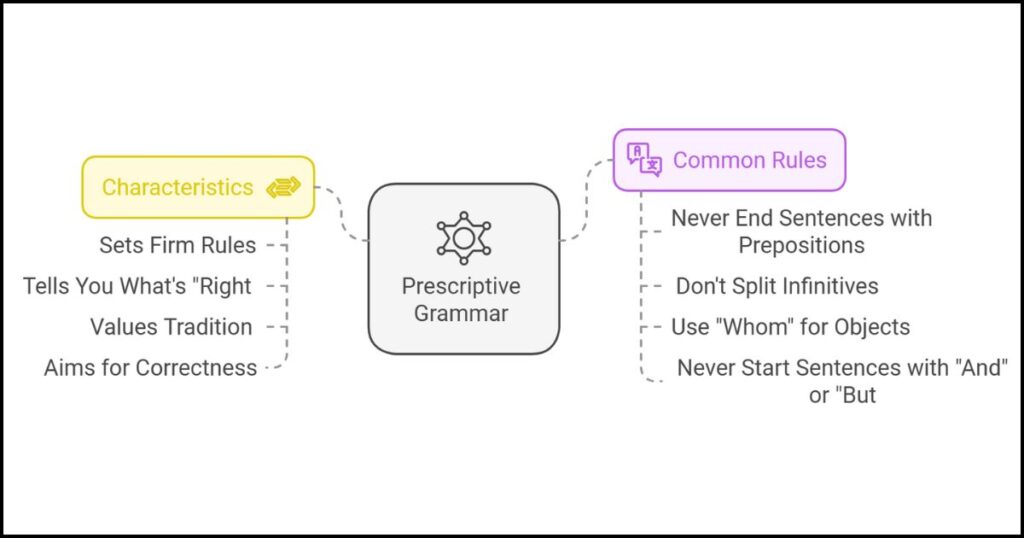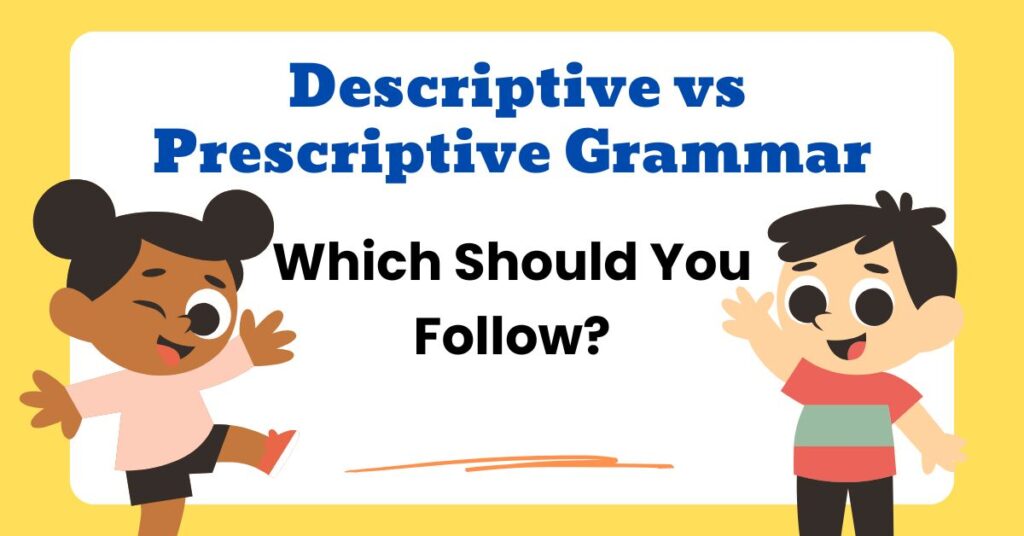Ever wondered why some people say “ain’t” while others insist on using proper grammar? Or why certain grammar rules seem to change over time? Well, that’s where descriptive vs prescriptive grammar comes into play. In this blog, we’ll explore these two sides of the grammar coin, dive into their key differences, and give you some tips on how to understand them better. By the end, you’ll have a clearer idea of how both influence the way we communicate and how you can apply them in your own writing and speech
Contents
ToggleWhat is Descriptive Grammar?
Descriptive grammar refers to the way language is actually used by speakers. It doesn’t care if a sentence is “correct” or “wrong” according to traditional grammar rules. Instead, it focuses on how people naturally speak, write, and express themselves. In other words, it’s the “real-life” version of grammar, based on actual usage rather than rules that are supposed to be followed.
Example of Descriptive Grammar:
“I ain’t got no money.”
Although this sentence would raise eyebrows in more formal settings, it’s perfectly fine in casual, everyday conversations. Descriptive grammar acknowledges that language evolves and varies depending on culture, geography, and personal preference. For instance, the use of “ain’t” is common in many English dialects, and descriptive grammar doesn’t judge it.
What is Prescriptive Grammar?
On the flip side, prescriptive grammar is all about the rules. It dictates what is considered “correct” or “incorrect” based on established language norms. Prescriptive grammarians believe there’s a right and wrong way to speak or write, and these rules shouldn’t be ignored. This is the version of grammar you’ll find in school textbooks and formal writing guides.
Example of Prescriptive Grammar:
“I don’t have any money.”
This sentence adheres to the standard rules of grammar, avoiding double negatives and incorrect contractions. Prescriptive grammar focuses on ensuring clear and correct communication by following these traditional standards
 Descriptive vs Prescriptive Grammar
Descriptive vs Prescriptive Grammar
Differences Between Descriptive and Prescriptive Grammar
Now that we’ve broken down both concepts, let’s highlight the key differences:
1. Approach to Language
Descriptive Grammar: Focuses on how language is used in practice, regardless of whether it follows traditional rules.
Prescriptive Grammar: Emphasizes following language rules and formal standards.
2. Flexibility
Descriptive Grammar: More flexible, accepting changes and variations in how people communicate.
Prescriptive Grammar: Less flexible, sticking to established norms.
3. Purpose
Descriptive Grammar: Aims to document and understand language as it evolves.
Prescriptive Grammar: Aims to maintain consistency and correctness in language use.
4. Examples in Everyday Speech
Descriptive Grammar: “Me and him went to the store.”
Prescriptive Grammar: “He and I went to the store.”
Here are 25 examples of both descriptive and prescriptive grammar, followed by a table comparing them:
25 Examples of Descriptive Grammar
Me and him went to the store.
She don’t like it.
They was playing soccer yesterday.
He be working all the time.
Ain’t nobody got time for that.
We was at the park earlier.
I ain’t got no money.
He don’t know how to cook.
She gonna be late.
I seen that movie last week.
She’s got some real good vibes.
I ain’t never seen anything like that before.
This ain’t no time to be slacking.
They’ve been here for a while now.
I don’t got no homework.
He’s always talking like that.
You got a friend in me.
I could care less about that.
I could of gone with you.
He come home late every night.
She gonna fix dinner soon.
I done told him about it.
You was always there for me.
It’s a whole bunch of things to do.
We might go there later.
25 Examples of Prescriptive Grammar
He and I went to the store.
She doesn’t like it.
They were playing soccer yesterday.
He works all the time.
Nobody has time for that.
We were at the park earlier.
I don’t have any money.
He doesn’t know how to cook.
She will be late.
I saw that movie last week.
She has some very good vibes.
I have never seen anything like that before.
This is not the time to be slacking.
They have been here for a while now.
I don’t have any homework.
He always talks like that.
You have a friend in me.
I couldn’t care less about that.
I could have gone with you.
He comes home late every night.
She will fix dinner soon.
I have already told him about it.
You were always there for me.
There are many things to do.
We might go there later.
Differences Between Descriptive and Prescriptive Sentences
| Descriptive Grammar | Prescriptive Grammar |
|---|---|
| Me and him went to the store. | He and I went to the store. |
| She don’t like it. | She doesn’t like it. |
| They was playing soccer yesterday. | They were playing soccer yesterday. |
| He be working all the time. | He works all the time. |
| Ain’t nobody got time for that. | Nobody has time for that. |
| We was at the park earlier. | We were at the park earlier. |
| I ain’t got no money. | I don’t have any money. |
| He don’t know how to cook. | He doesn’t know how to cook. |
| She gonna be late. | She will be late. |
| I seen that movie last week. | I saw that movie last week. |
| She’s got some real good vibes. | She has some very good vibes. |
| I ain’t never seen anything like that before. | I have never seen anything like that before. |
| This ain’t no time to be slacking. | This is not the time to be slacking. |
| They’ve been here for a while now. | They have been here for a while now. |
| I don’t got no homework. | I don’t have any homework. |
| He’s always talking like that. | He always talks like that. |
| You got a friend in me. | You have a friend in me. |
| I could care less about that. | I couldn’t care less about that. |
| I could of gone with you. | I could have gone with you. |
| He come home late every night. | He comes home late every night. |
| She gonna fix dinner soon. | She will fix dinner soon. |
| I done told him about it. | I have already told him about it. |
| You was always there for me. | You were always there for me. |
| It’s a whole bunch of things to do. | There are many things to do. |
| We might go there later. | We might go there later. |
How Descriptive and Prescriptive Grammar Impact Writing
Both descriptive and prescriptive grammar have their place in the world of language. If you’re writing an academic paper or a professional email, you’ll want to stick with prescriptive grammar. After all, following the rules ensures that your communication is clear, concise, and universally understood.
However, when you’re writing informally or in creative contexts like literature or dialogue, descriptive grammar can shine. It adds authenticity to characters and voice. Think about the way people speak in movies or novels—real people often don’t follow the grammar rules strictly, and neither should your characters if you want them to feel real.
Tips for Learning Descriptive and Prescriptive Grammar Easily
Whether you’re a student, a writer, or just someone wanting to brush up on their language skills, understanding both types of grammar is essential. Here are some tips for mastering them:
Know When to Use Each One: Use prescriptive grammar for formal writing like essays, business emails, or official reports. Use descriptive grammar in informal settings like conversations, personal writing, and dialogue.
Don’t Be Afraid of Flexibility: Language is constantly evolving. Just because something isn’t in the grammar book doesn’t mean it’s wrong. Stay aware of how language changes and adopt new terms or expressions when appropriate.
Practice with Exercises: If you’re unsure about where descriptive grammar and prescriptive grammar meet, try some exercises. Use sentences with double negatives, split infinitives, or informal contractions and decide whether they fit descriptive or prescriptive rules.
Be Culturally Sensitive: Language varies widely by region and culture. A sentence that’s acceptable in one part of the world may not be in another. Be mindful of these differences when communicating with a diverse audience.
Descriptive vs Prescriptive Grammar Exercises
Here are a couple of examples for you to try:
Exercise 1: Write a sentence using a double negative (e.g., “I don’t need no help”). Is it descriptive or prescriptive grammar?
Exercise 2: Write a formal email to a colleague and use only prescriptive grammar. Check if all your sentences are grammatically correct..
Descriptive vs Prescriptive Grammar
FAQs About Descriptive vs Prescriptive Grammar
1. What is the difference between Prescriptivist and Descriptivist grammar?
Prescriptivist grammar believes in strict adherence to traditional language rules and norms. It focuses on how language should be used according to established standards. For example, a prescriptivist would insist that “ain’t” is incorrect and should be avoided in formal writing.
Descriptivist grammar, on the other hand, studies language as it is used by speakers. It doesn’t judge forms or structures based on correctness but observes and documents how language naturally evolves in different contexts and communities.
2. What is an example of a prescriptivist?
An example of a prescriptivist approach would be the insistence that “split infinitives” (e.g., “to boldly go”) should be avoided. Prescriptivists would argue that the correct form is “to go boldly,” following traditional grammar rules that consider the split infinitive to be incorrect.
3. What is the difference between prescription and description?
Prescription refers to enforcing a specific set of rules or standards about language usage. It’s about how language should be used.
Description, on the other hand, is about observing and documenting how language is actually used by speakers, regardless of whether it follows traditional rules or not. It’s the difference between “how it is” vs “how it should be.”
4. Is English grammar prescriptive or descriptive?
English grammar can be both prescriptive and descriptive, depending on the context. In formal settings like academic writing, prescriptive grammar is typically followed. However, in everyday speech, social media, and literature, descriptive grammar often takes precedence, reflecting how people actually speak and communicate.
5. What is the difference between descriptive and prescriptive communication?
Descriptive communication focuses on how people naturally express themselves. It reflects the various styles, dialects, and informal speech patterns used in real-life conversations.
Prescriptive communication, in contrast, stresses adhering to formal communication norms, emphasizing clarity, structure, and grammatical correctness, especially in professional or academic settings.
Final thoughts on Descriptive vs Prescriptive Grammar
In the world of grammar, there’s no one-size-fits-all answer. Both descriptive and prescriptive grammar have their merits and play important roles in communication. Understanding when and how to use each can make you a more effective communicator, whether you’re writing an academic paper, chatting with friends, or crafting a creative story.
So, what are you waiting for? Start practicing, experimenting, and having fun with both descriptive and prescriptive grammar in your writing. And remember, just like language itself, your understanding of grammar will keep evolving!



